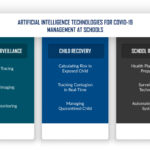ARTIFICIAL INTELLIGENCE FOR COVID-19 MANAGEMENT AT SCHOOLS
Artificial intelligence technologies facilitate the safe re-opening of schools by surveilling the transmission of COVID-19. AI systems, machine learning and automation play an important role in the detection, school-level screening…

